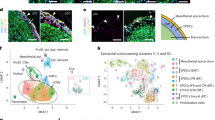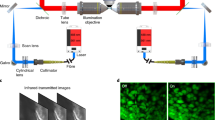Summary
The formation of the epicardium was investigated in the mouse embryo using scanning electron microscopy (SEM) in order to establish a three-dimensional perspective concerning epicardial development in mammals. The epicardium first appears as aggregates of cells scattered on the caudal surface of the ventricle and atria where these regions face the septum transversum in a 9-day-old embryo. These aggregated cells seem to have originated from the mesothelial projections extending from the surface of the septum transversum. Then, the cells of each aggregate flatten, subsequently fusing with each other to form a continuous sheet of epicardium. The fusion of aggregates proceeds in a cranial direction. Finally, the bulbus cordis and truncus arteriosus become invested by migrating cells at the cranial end of the epicardial sheet about 11 days after fertilization. The present observations are discussed in comparison with those made previously in avian embryos.
Similar content being viewed by others
References
Abercrombie M, Heaysman JEM, Pegrum SM (1971) The locomotion of fibroblasts in culture. IV. Electron microscopy of the leading lamella. Exp Cell Res 67:359–367
Challice CE, Virágh S (1973) The embryonic development of the mammalian heart. In: Challice CE, Virágh S (eds) Ultrastructure of the mammalian heart. Academic Press, New York, pp 91–126
Ho E, Shimada Y (1978) Formation of the epicardium studied with the scanning electron microscope. Dev Biol 66:579–585
Kurkievicz T (1909) Zur Kenntnis der Histogenese des Herzmuskels der Wirbeltiere. Bull Acad Sci Cracovie 1909:148–191
Manasek FJ (1969) Embryonic development of the heart. II. Formation of the epicardium. J Embryol Exp Morphol 22:333–348
Patten BM (1960) The development of the heart. In: SE Gould (ed) The pathology of the heart. Charles C Thomas, Springfield, III
Shimada Y, Ho E (1980) Scanning electron microscopy of the embryonic chick heart: Formation of the epicardium and surface structure of the four heterotypic cells that constitute the embryonic heart. In: R van Praag, A Takao (eds) Etiology and morphogenesis of congenital heart disease. Futura, Mount Kisco, New York, pp 63–80
Shimada Y, Ho E, Toyota N (1981) Epicardial covering over myocardial wall in the chicken embryo as seen with the scanning electron microscope. Scan Electron Microsc 1981/II:275–280
Virágh S, Challice CE (1973) Origin and differentiation of cardiac muscle cells in the mouse. J Ultrastruct Res 42:1–24
Author information
Authors and Affiliations
Rights and permissions
About this article
Cite this article
Komiyama, M., Ito, K. & Shimada, Y. Origin and development of the epicardium in the mouse embryo. Anat Embryol 176, 183–189 (1987). https://doi.org/10.1007/BF00310051
Accepted:
Issue Date:
DOI: https://doi.org/10.1007/BF00310051




